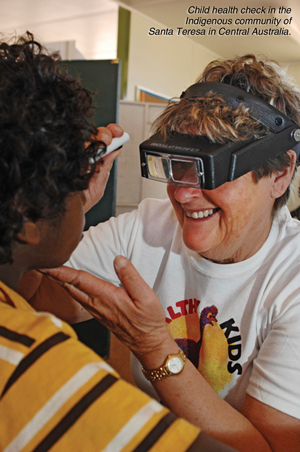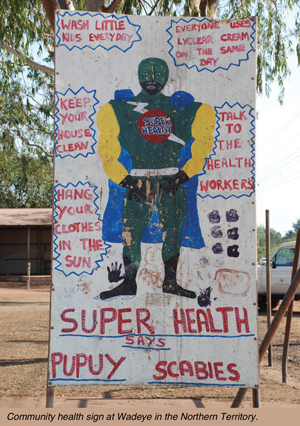For the first time, there is a real opportunity to deal comprehensively with the shameful situation of Indigenous communities in Australia — but the commitment needs to be huge
It is remarkable to contemplate that in parts of Australia, there is a health crisis that is in some respects more devastating than anywhere else in the world. The Australian Medical Association has called the state of health and lack of health services endured by Aboriginal peoples and Torres Strait Islanders a national tragedy and a national shame. The former president of the association, Dr Mukesh Haikerwal, wrote earlier this year: “I think we are being kind in that assessment.”1 The figures for renal and coronary heart disease among Indigenous peoples could well be the worst in the world. For instance, Indigenous Australians are three times more likely to have a major coronary event than other Australians, and 1.5 times more likely to die after such an event.1
Some good things have been done, but not on a scale to make a real difference — until now.
The Australian Government’s Northern Territory Emergency Response2 is without precedent in Australia. It is the largest and most significant whole-of-government initiative yet carried out in this country. The government set up the Northern Territory Emergency Response Taskforce (Box) to provide advice and to oversee the implementation of the emergency measures.
The intervention has three broad objectives:
stabilisation to protect children and secure their communities;
normalisation of services and infrastructure; and
in the longer term, sustainability, bringing Indigenous Australians fully into line with the choices other Australians enjoy.
The government committed $587 million for the stabilisation phase in the 2007–08 financial year. This is for urgent and immediate actions. It includes over $83 million specifically for improving child and family health, with $205.8 million for employment and welfare reform and the balance for promoting law and order, enhancing education, supporting families and for housing and land reform.2
On 18 September 2007, the government announced further funding of $740 million to highlight its long-term commitment, bringing the total committed so far to $1.3 billion. This includes $100 million over 2 years from the 2008–09 financial year for more doctors, nurses, allied health professionals and specialist services.2
When the response was announced on 21 June 2007, many were concerned about its motivation and methods.3 Was this not paternalism or yet another attempt to dominate Indigenous communities? Well, while it is still early days in an intervention to which the Australian Government has committed itself for at least 5 years, I have seen how this response is already bearing fruit and believe everyone with concern for Indigenous health should continue to support this initiative. We cannot let this opportunity go.
For instance, the introduction of strict controls over alcohol consumption had a huge impact almost immediately. An Indigenous woman told me that, for the first time she could remember, she had had a week of sleeping peacefully. A sharp reduction in the physical abuse of women and children has also been seen. The Chair of the Northern Territory Emergency Response Taskforce, Dr Sue Gordon (Box), reports that in communities across the NT, women are talking about the positive effects of alcohol bans in reducing violence, abuse and antisocial behaviour. The same thing is probably happening with levels of child sexual abuse — the horror which sparked off this emergency response — although it will only be when more trust has been built up that we will be able to explore this more fully.
The findings of these checks are sobering, and underline the need for the intervention. We already knew that the children in many of these communities had very high rates of chronic diseases, but have found that the situation is even worse than the official picture. The Indigenous population has a burden of disease up to six times higher than in the non-Indigenous population.4
Probably 80% of the Indigenous children have middle-ear diseases. Intestinal parasites and skin infections are rife. An absence of water for washing — taps don’t run, toilets don’t flush, there is no soap — has led to skin hygiene so poor that pathogens thrive. This in turn contributes to the devastating levels of renal disease and heart disease, the latter particularly associated with rheumatic fever. Type 2 diabetes is also increasingly common in children.5
Strategies in the stabilisation and normalisation phases of the initiative include:
voluntary health checks available for all children aged under 16 years in target communities;
development of a range of special services for children and their families who have suffered trauma from physical, sexual and emotional abuse or neglect;
increased police presence to guarantee safety and security for community members;
implementation of alcohol-management plans;
a focus on getting children to school;
support for and an extension of the current nutrition programs for Indigenous children;
establishment of crèches in communities;
funding for new housing and renovations;
a focus on creating real jobs within the communities and incentives to develop local businesses;
the appointment of government business managers in each community;
government assistance to the Northern Territory Government to expand child-protection services and increase the number of safe houses;
changed welfare payment rules to ensure money meant for children is spent on them, including quarantining welfare payments to parents or carers if children do not attend school;
a licensing program for community stores to ensure families have access to a range of healthy foods;
acquiring 5-year leases over the main townships to ensure the job is done quickly; and
opening up communities by changing the permit system so that people can visit common areas within them.
Northern Territory Emergency Response Taskforce2
Dr Sue Gordon AM (Chair), a magistrate in the Perth Children’s Court and chair of the Australian Government’s National Indigenous Council.
Major General Dave Chalmers AO, CSC (Operational Commander), who has considerable organisational and command experience, notably in East Timor and as commander of the joint taskforce that provided humanitarian relief to Sumatra after the 2004 Boxing Day tsunami.
Dr Bill Glasson, ophthalmologist and former president of the Australian Medical Association, who has worked on a voluntary basis in a number of Aboriginal communities and in East Timor.
Roger Corbett AM, member of the Reserve Bank of Australia Board and former chief executive of Woolworths.
Miriam Rose Baumann AM, principal of St Francis Xavier Catholic School in Daly River, a member of the National Indigenous Council, and chair of the Aboriginals Benefit Account Advisory Committee.
Dr Peter Shergold AC, secretary of the Department of the Prime Minister and Cabinet.
Paul Tyrrell, chief executive of the Northern Territory Department of the Chief Minister.
- 1. Haikerwal M. Equal health access a priority for Aboriginal and Torres Strait Islander Australians. Australian Medical Association Report Card Series 2007. Aboriginal and Torres Strait Islander Health. Canberra: AMA, 2007. http://www.ama.com.au/web.nsf/doc/WEEN-73EVX9/$file/Reportcard_2007.pdf (accessed Nov 2007).
- 2. Australian Government. Northern Territory Emergency Response — fact sheets. Canberra: Australian Government, October 2007. http://www.facsia.gov.au/nter/docs/factsheet_all.pdf (accessed Nov 2007).
- 3. Ring IT, Wenitong M. Interventions to halt child abuse in Aboriginal communities [editorial]. Med J Aust 2007; 187: 204-205. <MJA full text>
- 4. Vos T, Baker B, Stanley L, Lopez A. The burden of disease and injury in Aboriginal and Torres Strait Islander peoples, 2003. Brisbane: The University of Queensland, 2007.
- 5. Craig ME, Femia G, Broyda V, et al. Type 2 diabetes in Indigenous and non-Indigenous children and adolescents in New South Wales. Med J Aust 2007; 186: 497-499. <MJA full text>







I acknowledge the child health care teams for giving their time and skills to support this initiative. Recognition must also be given to the work of the doctors, nurses and Aboriginal health workers who live and work in the remote areas of the Northern Territory and remain committed to the health of both the Indigenous and non-Indigenous inhabitants. It is important to engage these health professionals in building long-term sustainability for the region.
None identified.